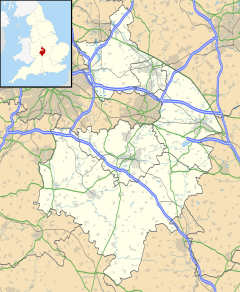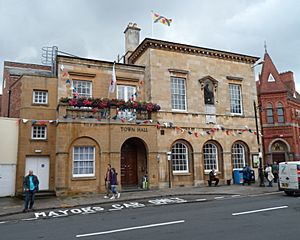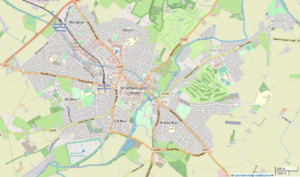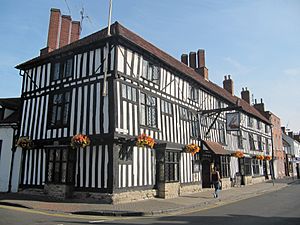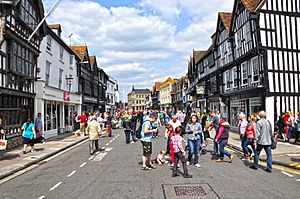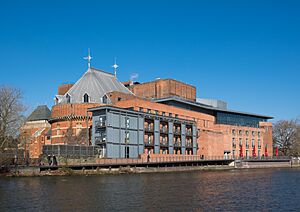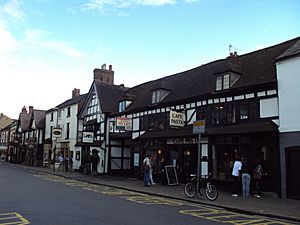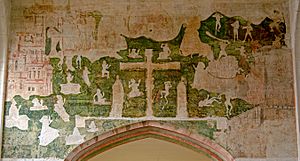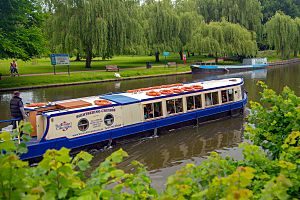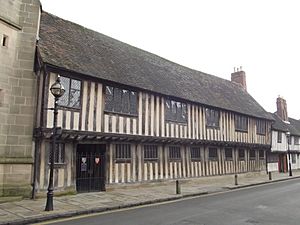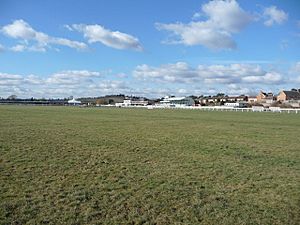Stratford-upon-Avon facts for kids
Quick facts for kids Stratford-upon-Avon |
|
|---|---|
| Town | |
|
Town Centre from the end of High Street
Royal Shakespeare Theatre
Anne Hathaway's Cottage
|
|
| Population | 30,495 (2021 census) |
| Demonym | Stratfordian |
| OS grid reference | SP1955 |
| Civil parish |
|
| District |
|
| Shire county | |
| Region | |
| Country | England |
| Sovereign state | United Kingdom |
| Post town | STRATFORD-UPON-AVON |
| Postcode district | CV37 |
| Dialling code | 01789 |
| Police | Warwickshire |
| Fire | Warwickshire |
| Ambulance | West Midlands |
| EU Parliament | West Midlands |
| UK Parliament |
|
Stratford-upon-Avon, often just called Stratford, is a charming market town in England. It's located in the county of Warwickshire, in the West Midlands region. The town sits right by the beautiful River Avon. It's about 91 miles (146 km) north-west of London. It's also 22 miles (35 km) south-east of Birmingham. In 2021, about 30,495 people lived here.
Long ago, Britons and then Anglo-Saxons lived in this area. Stratford was a small village until 1196. That year, a lord named John of Coutances planned to make it a town. King Richard I gave Stratford permission to hold a weekly market. This made it a special "market town." Trade and business grew a lot after that.
Today, Stratford is famous worldwide. It's the birthplace and burial place of the amazing writer William Shakespeare. Many people call him England's national poet. About 2.7 million visitors come here every year! The famous Royal Shakespeare Company performs in the Royal Shakespeare Theatre in town.
Contents
- What's in a Name? The Meaning of Stratford
- A Journey Through Time: Stratford's History
- How Stratford is Governed
- Exploring Stratford's Geography
- Stratford's Climate
- People and Population: Demographics
- Stratford's Economy and Jobs
- Culture and Entertainment
- Famous Streets of Stratford
- Other Fun Attractions
- Getting Around: Transport
- Learning in Stratford: Education
- Sports and Recreation
- Places of Worship: Churches
- Famous People from Stratford
- Sister Cities: Twin Towns
- Freedom of the Town
- See also
What's in a Name? The Meaning of Stratford
The name Stratford-upon-Avon tells us a lot about the town. It comes from three old words. Strǣt is an Old English word for 'street'. This refers to an old Roman road that crossed the area. Ford means a shallow place in a river. People could walk or drive across it. The word Avon is a Celtic word for 'river'. So, Stratford-upon-Avon means "the street's ford on the River Avon."
This special river crossing was used since Roman times. Later, the Clopton Bridge was built there. The name "Stratford" first appeared in records around 1251. It described the area near the Holy Trinity Church.
A Journey Through Time: Stratford's History
Ancient Roman Times
People lived in the Stratford area during the Roman period. A Roman road crossed through here. Archaeologists found remains of a small Roman town. It was about 1 mile (1.6 km) northeast of today's town center. This settlement, called Tiddington, was active from the 1st to the 5th century AD. Other Roman settlements were also found nearby.
Medieval Beginnings
Anglo-Saxons first settled here in the 7th century. It was part of the Kingdom of Mercia. A monastery likely stood where Holy Trinity Church is now. Viking invaders probably destroyed it in 1015. The land belonged to the Bishops of Worcester for centuries. The area around Holy Trinity Church is still called Old Town. This was the first settlement. Later, the town center moved closer to the river. This was better for trade.
Stratford was a village until the late 12th century. Bishop John of Coutances helped it grow into a town in 1196. He created a new town plan. It was based on a grid system. This allowed people to rent property and trade. This was called burgage tenure. Each plot of land was about 0.25 acres. King Richard I gave Stratford a special charter in 1196. This allowed a weekly market. This made it a true market town. These two events made Stratford over 800 years old! The town celebrated its 800th anniversary in 1996.
As Stratford grew, it became a place for tradesmen and merchants. By 1252, there were about 240 rental properties. There were also shops and stalls. Tradesmen formed a guild called the Guild of the Holy Cross. This group helped with business and religious needs. It became the town's main local government. They built a Guild Chapel in the 13th century. A Guildhall and almshouses followed around 1417. The guild also started a school in the late 13th century.
Many important old buildings are on Stratford's Historic Spine. This was once the main path from the town center to the church. It starts at Shakespeare's Birthplace on Henley Street. It goes through High Street with many Elizabethan buildings. These include Harvard House. The path continues through Chapel Street. Here you find Nash's House and New Place. The Falcon Hotel (now Hotel Indigo) is also here. It's a timber-framed house from the 15th century. The Historic Spine then reaches Church Street. This area has the Guild buildings and older homes. It ends in the Old Town. Here are Hall's Croft and Holy Trinity Church.
For a long time, the only way to cross the River Avon was a wooden bridge. It was first mentioned in 1235. Sometimes, the river flooded, making it impossible to cross. In 1484, a new stone bridge was built. It was called Clopton Bridge. Hugh Clopton, a rich local man, paid for it. This new bridge made trade much easier. It also helped travelers visit the town.
Tudor Times and Shakespeare
During the Tudor period, local government changed. The Guild of the Holy Cross was closed in 1547. The town then asked the King for a new charter. They received it in 1553. This created a new Town Council. It took over the guild's property and duties. The charter also restarted Stratford's school as the King Edward VI School.
The nearby Cotswolds were famous for sheep. Stratford became a center for wool and sheep products. This led to industries like tanning (making leather). Glove making was also very important. Another key industry was malting, which processed grain.
John Shakespeare, William Shakespeare's father, moved to Stratford in 1551. He became a successful glove maker and businessman. He also served on the Town Council. He married Mary Arden around 1557. Their most famous child, William Shakespeare, was born in 1564. He was likely born in the house now known as Shakespeare's Birthplace.
The 17th and 18th Centuries
Stratford saw some fighting during the English Civil War. Its location made it important for both sides. It was mostly controlled by the Parliamentarian army. In February 1643, Royalist forces briefly took the town. Parliamentarians quickly recaptured it. A notable event was the destruction of the Market Hall. Three barrels of gunpowder stored there exploded in February 1643. Famous people like Prince Rupert and Oliver Cromwell visited Stratford during this time.
The town grew slowly for a while. But in the late 18th century, more land was developed. This led to new streets like John Street and Payton Street. In 1769, the actor David Garrick held a big Shakespeare Jubilee. This event brought many visitors. It helped make Stratford a popular tourist spot.
Before roads and railways, canals were vital. The River Avon was made navigable in 1639. This connected Stratford to the River Severn. It allowed trade of goods like sugar, oil, and wine. In return, corn and cheese came to Stratford.
From the 19th Century to Today
Between 1793 and 1816, the Stratford-upon-Avon Canal was built. This linked Stratford to Birmingham. By the early 1800s, Stratford was a busy port. It had many canal and river wharves.
The first railway in Warwickshire reached Stratford in 1826. It was a horse-drawn wagonway. This tramway carried goods between the canal and nearby towns. It stopped being used in the early 1900s. The Tramway Bridge over the Avon is a remnant of this.
Steam trains arrived in 1859 and 1860. They connected Stratford to the south and north. The current Stratford-upon-Avon railway station opened in 1861. These railway links helped the town's tourism grow.
Stratford didn't become a big industrial center. But some industries did develop. Edward Fordham Flower opened a large brewery in 1831. It operated until 1967. Other industries included lime kilns and making tarpaulin. River and canal transport declined with railways. The River Avon navigation was restored by volunteers in 1974.
Stratford's growth as a tourist spot continued in the Victorian era. Edward Fordham Flower and his son Charles helped a lot. They campaigned and raised money for the Shakespeare Memorial Theatre. It opened in 1879 by the Avon. The original theatre burned down in 1926. A new one, designed by Elisabeth Scott, opened in 1932. She was the first woman architect to design such an important building in Britain.
In 1974, the old borough of Stratford changed. It became part of the larger Stratford-on-Avon District. A new town council was formed. This council manages two old charities. These charities, called the Guild and College estates, own property. They give over £2 million in grants to the community each year (as of 2025).
How Stratford is Governed
Stratford-upon-Avon has different levels of local government. These groups help run the town and surrounding areas.
National Representation
Stratford is part of the Stratford-on-Avon area for national elections. This area has been represented by Manuela Perteghella since 2024. She is a member of the Liberal Democrats party.
Local Government Councils
Stratford has three main levels of local government:
- County-level: The Warwickshire County Council handles big issues. These include education, roads, and other important services for the whole county.
- District-level: The Stratford-on-Avon District Council manages local matters. This includes housing, town planning, and rubbish collection. It serves Stratford and nearby towns. Their office is at Elizabeth House.
- Parish-level: The Stratford-upon-Avon Town Council focuses on very local needs. They help with crime prevention, parks, and keeping the town clean. They also choose the town's mayor. The Town Council meets at the Town Hall. It has 18 members who represent different parts of the town.
Exploring Stratford's Geography
Stratford is about 22 miles (35 km) south-east of Birmingham. It's near the northern edge of the beautiful Cotswolds hills. Chipping Campden is about 10 miles (16 km) to the south. Stratford is also close to the borders of Worcestershire and Gloucestershire.
The River Avon flows through Stratford. Most of the town is on the west side of the river. Because of its riverside location, the town can sometimes experience flooding.
Stratford has several smaller areas, or suburbs. These include Alveston, Shottery, and Tiddington. They used to be separate villages but are now part of Stratford. Other areas are Bishopton, Bridge Town, Clopton, and Old Town.
Directions from Stratford-upon-Avon
 |
Redditch, Birmingham | Solihull Henley-in-Arden |
Coventry, Rugby Warwick, Leamington Spa |
 |
| Worcester, Droitwich, Alcester | Southam, Daventry, Northampton | |||
| Evesham, Tewkesbury, Gloucester | Chipping Norton, Witney, Cirencester, Swindon | Banbury, Oxford, Reading, London |
Stratford's Climate
Stratford has a mild maritime climate, typical for the British Isles. This means it rarely gets extremely hot or cold. The town gets a moderate amount of sunshine, about 1,379 hours each year. Rain falls fairly evenly throughout the year. On average, Stratford receives 622 mm of rain annually. It rains more than 1 mm on about 114 days each year.
July is usually the warmest month, with an average high of 22.2°C. January is the coldest, with an average high of 6.9°C. The highest temperature ever recorded was 35.7°C in August 1990. The lowest was -21.0°C in January 1982.
| Climate data for Stratford-upon-Avon, elevation 49 metres (161 feet), 1971–2000 (extremes 1959–2003) | |||||||||||||
|---|---|---|---|---|---|---|---|---|---|---|---|---|---|
| Month | Jan | Feb | Mar | Apr | May | Jun | Jul | Aug | Sep | Oct | Nov | Dec | Year |
| Record high °C (°F) | 14.5 (58.1) |
18.7 (65.7) |
23.3 (73.9) |
22.8 (73.0) |
29.3 (84.7) |
32.9 (91.2) |
33.7 (92.7) |
35.7 (96.3) |
28.9 (84.0) |
26.9 (80.4) |
17.2 (63.0) |
15.6 (60.1) |
35.7 (96.3) |
| Mean daily maximum °C (°F) | 6.9 (44.4) |
7.5 (45.5) |
10.2 (50.4) |
12.8 (55.0) |
16.5 (61.7) |
19.4 (66.9) |
22.2 (72.0) |
21.7 (71.1) |
18.5 (65.3) |
14.3 (57.7) |
9.9 (49.8) |
7.7 (45.9) |
14.0 (57.2) |
| Mean daily minimum °C (°F) | 0.7 (33.3) |
0.5 (32.9) |
2.0 (35.6) |
3.2 (37.8) |
5.8 (42.4) |
8.8 (47.8) |
10.9 (51.6) |
10.7 (51.3) |
8.7 (47.7) |
6.0 (42.8) |
2.8 (37.0) |
1.5 (34.7) |
5.2 (41.4) |
| Record low °C (°F) | −21.0 (−5.8) |
−12.2 (10.0) |
−11.7 (10.9) |
−8.2 (17.2) |
−5.5 (22.1) |
−1.6 (29.1) |
0.6 (33.1) |
0.6 (33.1) |
−3.3 (26.1) |
−5.8 (21.6) |
−9.1 (15.6) |
−19.1 (−2.4) |
−21.0 (−5.8) |
| Average precipitation mm (inches) | 55.6 (2.19) |
40.6 (1.60) |
45.6 (1.80) |
46.5 (1.83) |
48.8 (1.92) |
55.3 (2.18) |
44.0 (1.73) |
61.1 (2.41) |
55.0 (2.17) |
56.2 (2.21) |
52.0 (2.05) |
61.4 (2.42) |
622.3 (24.50) |
| Mean monthly sunshine hours | 48.7 | 61.3 | 95.2 | 132.0 | 177.0 | 167.1 | 189.4 | 177.9 | 129.6 | 98.0 | 60.6 | 42.5 | 1,379.2 |
| Source 1: Met Office | |||||||||||||
| Source 2: Starlings Roost Weather | |||||||||||||
People and Population: Demographics
In the 2021 census, Stratford had a population of 30,495 people. This was an increase from 27,894 in 2011 and 22,338 in 2001. The town's population has grown recently. This is due to new homes being built in areas like Shottery and Bishopton.
In 2021, most Stratford residents (92.7%) were White. About 3.3% were Asian, and 0.6% were Black. Around 2.4% were Mixed ethnicity.
Regarding religion in 2021, 58.4% of residents were Christian. About 38.2% said they had no religion. Other religions included Muslim (1.0%), Hindu (0.8%), Sikh (0.5%), and Buddhist (0.5%).
Stratford's Economy and Jobs
Tourism is a huge part of Stratford's economy. Many people work in hotels, restaurants, and cafes. Other industries include boat building, bicycle manufacturing, and engineering. Food production, Information Technology, and call centres are also important. The town has a large retail sector and many shops.
Major employers include NFU Mutual Insurance Company and Amec Foster Wheeler. Other big names are Sitel, Tesco, Morrisons, and Marks & Spencer. Pashley Cycles also has a presence here. The three theatres run by the Royal Shakespeare Company bring many visitors and jobs.
Tourism: A Major Attraction
The large number of tourists is key to Stratford's success. The town welcomes between 2.5 and 3 million visitors every year. Stratford is a top English tourist town because it's William Shakespeare's birthplace. Many people believe he was the greatest playwright of all time.
In 2010, the local council spent £298,000 to promote tourism. This included a new tourism website and information center. The council also supports an open-top bus tour.
Shopping in Stratford
Besides the town center, there are other shopping areas. Maybird Shopping Park, or "The Maybird," is a large center. It's on Birmingham Road, a short drive from town. The Rosebird Centre is smaller, on Shipston Road. It has a Waitrose supermarket and other shops. Bell Court Shopping Centre is in the town center. It offers restaurants and shops.
Culture and Entertainment
Theatre: The Heart of Stratford
The first theatre in Stratford was a temporary wooden one. Actor David Garrick built it in 1769. It was for his Shakespeare Jubilee to celebrate Shakespeare's birthday. In 1864, another temporary theatre was built for Shakespeare's 300th anniversary.
In the 1870s, Charles Edward Flower gave land for a permanent theatre. The first Shakespeare Memorial Theatre opened in 1879. It was very successful. This theatre burned down in 1926. Productions moved to a local cinema.
A competition chose Elisabeth Scott to design a new theatre. The new Royal Shakespeare Theatre opened in 1932. It was the first major building in Britain designed by a woman architect. Sir Peter Hall formed the Royal Shakespeare Company (RSC) here in 1961.
The RSC also runs two smaller theatres. The Swan Theatre was built in the 1980s. It's modeled on an Elizabethan theatre. The Other Place is another RSC theatre. The Royal Shakespeare Theatre and Swan Theatre closed for updates in 2007. They reopened in 2010. The Other Place reopened in 2016 as a 200-seat studio theatre.
Stratford also has The Bear Pit Theatre, a 100-seat volunteer-run venue. The Attic Theatre is a smaller, fringe theatre. It has 90 seats in a historic building. The Waterside Theatre is now the Clore Learning Centre. It's the RSC's education and event space.
Filming and Television

The town is the setting for the 2018 BBC detective show Shakespeare & Hathaway: Private Investigators.
Music Scene
Stratford ArtsHouse, formerly the Civic Hall, hosts the Orchestra of the Swan. This professional orchestra performs concerts with international soloists. The Rudolf Kempe Society's studio, The Muses, also hosts musical events.
Museums and Shakespeare's Homes
Tudor World is a museum in a historic Tudor building. It shows what life was like when Shakespeare lived. The Mechanical Art and Design museum, or MAD museum, is on Henley Street. It features "brilliant-but-bonkers machines" by Kinetic artists.
The Shakespeare Birthplace Trust cares for five houses linked to William Shakespeare. These include Hall's Croft, home of his daughter Susanna. Nash's House is next to New Place, where Shakespeare died. In Shottery is Anne Hathaway's Cottage, his wife's family home. Mary Arden's House, his mother's home, is in Wilmcote.
King Edward VI School is thought to be where Shakespeare studied. The schoolroom opened to visitors in 2016.
Literary Events
Stratford has one library on Henley Street. Since 2008, the town has hosted the Stratford-upon-Avon Literary Festival. It holds two events each year, in spring and autumn. The festival features talks by famous guests and workshops. It has become a well-known literary festival.
Shakespeare's Birthday Celebrations
Every year, Stratford celebrates Shakespeare's birthday. The celebration happens over two days. It's on the weekend closest to April 26th, his christening date. Events include music, drama, and a parade through town. In 2016, special events marked 400 years since Shakespeare's death.
Local Pubs
The Garrick Inn is said to be Stratford's oldest pub. An inn has been on its site since medieval times. The Dirty Duck, by Waterside, is popular with actors from the RSC theatres. The Campaign for Real Ale (CAMRA) holds a cider and beer festival here each year.
Local Media
Local news and TV are provided by BBC West Midlands and ITV Central. Radio stations include BBC CWR, Capital Mid-Counties, Hits Radio Coventry & Warwickshire, and Welcombe Radio. The main local newspapers are Stratford Observer and Stratford Herald.
Famous Streets of Stratford
Church Street
Church Street is an extension of Chapel Street and High Street. It features the old front of King Edward VI School. This is the school where Shakespeare is believed to have studied.
Henley Street
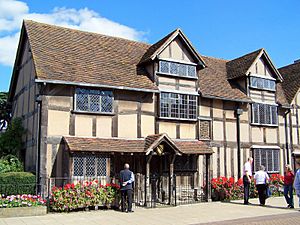
Henley Street is one of Stratford's oldest streets. It changed a lot between the 16th and 19th centuries. John Shakespeare bought his large half-timbered house here in 1556. His son William was born there in 1564. This house is now known as Shakespeare's Birthplace.
The property stayed with Shakespeare's family until 1670. His granddaughter, Elizabeth Barnard, left it to a relative. The main house became an inn called the Maidenhead. Later, it was called the Swan and Maidenhead. The Hart family, Shakespeare's relatives, lived in the small cottage next door.
In the late 19th century, Edward Gibbs restored the building. He made it look more like the original Tudor farmhouse. Next to Shakespeare's Birthplace is the Shakespeare Centre, built in 1964. The old White Lion Inn is also on Henley Street. It's now home to several shops and a tourist information center. Henley Street is a busy area for tourists and shoppers. It has many outdoor cafes and street entertainers.
Scholars Lane
Scholars Lane is across from King Edward VI School. It was part of the town's original grid plan from 1196. Its first name, around 1330, was Tinkers Lane. This is where tinkers would fix pots and pans on market days. Today, it's mostly a residential street.
Sheep Street
Sheep Street runs from Ely Street to Waterside. It was a residential area in the 16th century. Some buildings were rebuilt after a fire in 1595. Many, like Number 40, date back to 1480. As its name suggests, Sheep Street was where sheep were bought and sold. This continued until the late 19th century. Today, it's known as the town's restaurant hub.
The Shrieves House is one of the oldest homes still lived in. People say William Shakespeare based his character Sir John Falstaff on one of its residents. Oliver Cromwell is thought to have stayed here in 1651. Behind The Shrieves House is "Tudor World" museum. It shows 16th-century life. Shrieves Walk, a quaint path with small shops, is also nearby.
Waterside and Southern Lane
This area runs along the River Avon. It stretches from Bridge Street to Holy Trinity Church. It's also directly off Sheep Street and Chapel Lane. Here you can find the Waterside Theatre and the Royal Shakespeare Theatre. The Bancroft Gardens and river area are popular for picnics and river activities.
Bancroft Gardens features the Gower Monument. This bronze statue shows William Shakespeare with four of his famous characters. In summer, the River Avon is busy with boats. The Stratford-upon-Avon Canal is full of colorful narrowboats. You can often see jugglers and magicians entertaining people on the lawns.
At the edge of the gardens is the Swan Fountain. Queen Elizabeth II unveiled it in 1996. It marked Stratford's 800 years as a market town. The Stratford Town Walk starts here daily. It's a guided tour of Shakespeare's houses, theatres, and historic buildings. It also visits Holy Trinity Church, where Shakespeare was baptized and buried. Waterside is also home to The Dirty Duck pub. Actors and theatregoers often visit it.
Other Fun Attractions
Harvard House is at 26 High Street. Other attractions include the Stratford Butterfly Farm. It's on the eastern side of the River Avon. The Stratford Armouries is about 3 miles (4.8 km) from the town center. Each year, around October 12th, Stratford hosts a large mop fair. Ten days later, a smaller Runaway fair is held.
The Guild Chapel, at Church Street and Chapel Lane, has ties to Shakespeare's family. It features beautiful paintings from the early 1500s. These were covered during the Reformation to protect them. Centuries later, they were uncovered and can now be seen.
Getting Around: Transport
Road Travel
Stratford is 22 miles (35 km) from Birmingham. It's easy to reach from junction 15 of the M40 motorway. The A46 road connects Stratford to the M40. It also links to Warwick and Coventry to the north-east. To the south-west, it goes to Evesham and Ashchurch.
Bus Services
Bus services are mainly provided by Stagecoach in Warwickshire and Diamond West Midlands. Routes connect Stratford to nearby places. These include Banbury, Coventry, Evesham, Leamington, and Redditch.
Railway Connections
Stratford now has two railway stations. Stratford-upon-Avon is the main town center station. Stratford-upon-Avon Parkway is on the north-western edge of town. It has park and ride facilities.
Both stations offer services from:
- West Midlands Trains: Services go to Solihull, Birmingham (Snow Hill and Moor Street), Kidderminster, and Worcester Foregate Street.
- Chiltern Railways: This route goes to Warwick and Leamington Spa. Some direct trains travel daily to/from London Marylebone.
Stratford station is the end point for two railway lines. These come from Birmingham and Hatton. There have been talks about restoring a link to Honeybourne to the south. This would involve rebuilding 6 miles (9.7 km) of track.
Water Travel
Several companies offer sightseeing cruises on the River Avon and the canal. Some use old river barges converted for tours. The town is where the Stratford-upon-Avon Canal meets the River Avon.
The manually-powered Stratford-upon-Avon chain ferry opened in 1937. It connects Waterside to the water meadows across the river. It was the last of its kind built in Britain.
Cycling Paths
The town has many cycle paths. The Stratford greenway is a 5-mile (8 km) traffic-free path. It used to be a railway line. Now, it's part of the Sustrans National Cycle Network. It follows the River Avon towards Welford-on-Avon and Long Marston.
Air Travel
Birmingham Airport is 18 miles (29 km) to the north-west. It offers flights to many places in the UK and around the world.
Learning in Stratford: Education
Stratford is home to several places for studying Shakespeare. These include the Shakespeare Birthplace Trust. It holds books and documents about the famous playwright. The Shakespeare Institute is also here.
William Shakespeare is believed to have studied at King Edward VI School. This used to be an all-boys school. Since September 2013, up to 25% of its Year 12 students can be girls. It's one of the few grammar schools left in England. It selects students based on the 11-plus examination. There's also an all-girls grammar school, Stratford-upon-Avon Grammar School for Girls. It's often called 'Shottery School' after its location.
Another secondary school is Stratford-upon-Avon School. There are many primary schools too. These include St. Gregory's Catholic Primary School and Stratford-upon-Avon Primary School. Bishopton Primary School, Willows Church of England Primary School, and Thomas Jolyffe Primary School are also in town. Stratford also has Stratford-upon-Avon College.
Sports and Recreation
Stratford-upon-Avon Rugby Club is on Loxley Road. The club has three senior teams and a junior team. The 1st XV team plays in Midlands 1 (West). The club also has many mini and junior sections. Stratford-upon-Avon Cricket Club Ground is by the River Avon. The first match recorded there was in 1880.
The town has a 5k parkrun event every Saturday at 9 am. It takes place on the Recreation Ground. A junior parkrun for kids aged 4 to 14 started in June 2019. Stratford Racecourse is about one mile from town. It hosts 18 horse racing meetings each year. It's a leading small National Hunt course. Adventure Bike Rider magazine is also based here.
Places of Worship: Churches
Famous People from Stratford
Many famous actors have lived or stayed in Stratford. This is because of the Royal Shakespeare Company. Some notable people include:
- William Shakespeare (1564–1616), the famous English playwright and poet.
- David Bradley, an actor known for the Harry Potter films.
- Craig Charles (1964–), actor and DJ from Red Dwarf, has lived in Stratford.
- Jeffery Dench, an actor, lived near Stratford until his death in 2014.
- Sarah Douglas (1952–), an actress, was born and raised here.
- Marc Elliott, actor from EastEnders, was born in Stratford.
- Sarah Ann Kennedy, actress and animator, grew up in Stratford. She voices characters in Peppa Pig.
- Simon Pegg, actor, studied at Stratford-upon-Avon College.
- Patrick Robinson (1963–), actor from Casualty, lives in Stratford.
- Mark Strickson, actor from Doctor Who.
Other notable residents include:
- Daniel Brocklebank, actor from Coronation Street.
- Arthur C. Clarke, author of 2001: A Space Odyssey, served in the RAF here.
- Marie Corelli, a romantic novelist, lived in Stratford from 1901 to 1924.
- Lord Digby Jones (1955–), a businessman, lives near Stratford.
- David Domoney (1963–), a gardener and TV host, lives in Stratford.
- Dion Dublin, a former English footballer, lived in Stratford.
- Susan Fletcher, a novelist and award winner.
- Simon Gilbert and Neil Codling from the band Suede grew up here.
- Members of the bands Klaxons and Pull Tiger Tail went to school in Stratford.
- John Krasinski (1979–), an American actor, studied at the Royal Shakespeare Company.
- Adrian Newey, a famous Formula 1 car designer.
- Andrew Pozzi (1992–), a 110m hurdler, was born in Stratford.
- Gordon Ramsay, the celebrity chef, moved to Stratford with his family in 1976.
- Quentin Willson (1957–), a motoring expert and journalist, lives in Stratford.
Sister Cities: Twin Towns
| Town | Country |
|---|---|
| Stratford, Victoria | Australia |
| Stratford, Ontario | Canada |
| Stratford, Prince Edward Island | Canada |
| Stratford, Taranaki | New Zealand |
| Stratford, Connecticut | United States |
Freedom of the Town
The following people have received the special honour of Freedom of the Town of Stratford-upon-Avon:
- Sir Kenneth Branagh: April 22, 2022.
- Dame Judi Dench: April 22, 2022.
See also
 In Spanish: Stratford-upon-Avon para niños
In Spanish: Stratford-upon-Avon para niños







